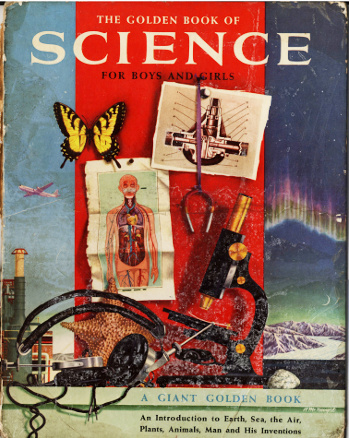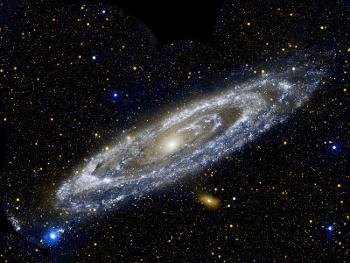The Mass of the Milky Way
September 8, 2014
When I was a young
child, I would enjoy reading, and re-reading, books about
science and
scientists. My
parents would feed my
addiction by buying me more books, like the
Golden Book of Science.[1] Interestingly, the full title of this book was, "The Golden Book of Science for Boys and Girls," but this was likely because the
author was a
woman, rather than it's being related to a true
gender equality in science in the
1950s.[2]

The Golden Book of Science for Boys and Girls (1956).
This profusely illustrated book was a good gloss of all fields of science for its readership.
It's interesting to see how far science has advanced from publication of this book to the present day.
(Scan of the cover of my copy.)[1)]
Reading such books, I would often be puzzled by certain statements of fact, one of which was the
weight (actually, the
mass) of the
Earth. How could someone possibly weigh the Earth? Eventually, I learned about the
Cavendish experiment, performed by
British physicist,
Henry Cavendish, in 1797-98. I wrote about the Cavendish experiment in an
earlier article (Big G, October 12, 2010).
In the typical "
standing on the shoulder's of giants"
theme, Cavendish quantified
Newton's law of universal gravitation by finding the value of "big G," the
gravitational constant. Big G is distinguished from "little g," which is the usual symbol for Earth's
gravitational acceleration. Newton's law is simply stated,

where
F is the gravitational
force between two masses,
m1 and
m1, and
r is the distance between them. Cavendish didn't actually calculate
G. He just calculated Earth's
density from his
data. Still, most people credit him with finding the value of
G, since plugging a few known numbers into Newton's formula would have given him that value in a minute. The present
CODATA value of
G is 6.67384 x 10
-11 m3 kg-1 s-2.
Going somewhat larger in scale, we can find the
mass of the Sun using
Kepler's third law; viz,

In which
T is the
orbital period of the Earth, or another
small planet,
a is the
semimajor axis of the planet's orbit,
G is the gravitational constant, and
M is the mass of the Sun. Rearranging the
equation to give the mass,

In this way we find that the Sun's mass is 332,946 times the mass of the Earth. This same technique can be used to estimate the mass of our
Milky Way Galaxy.
Stars at the
periphery of our galaxy orbit its center at about 250 km/s. plugging in an appropriate value for the
radius of the Milky Way gives about 1.5 x 10
12 solar masses, which would definitely equate to "
billions and billions" of stars if our Sun is an average star.[3] Applying the same technique to the nearby
Andromeda galaxy made us confident that Andromeda and the Milky Way have about the same mass.

The Andromeda galaxy (a.k.a., M31) as seen in ultraviolet light, color mapped with blue as far UV and orange as near UV).
(NASA/JPL-Caltech image via Wikimedia Commons.)
A new,
statistical measurement method, however, indicates that the Milky Way galaxy has half the mass of the Andromeda galaxy.[4-5] This new measurement is reported in a recent issue of the
Monthly Notices of the Royal Astronomical Society by an international team from the
University of Edinburgh (Edinburgh, UK), the
Instituto de Astrofísica de Andalucia-CSIC (Granada, Spain),
Cambridge University (Cambridge, UK), the
University of British Columbia (Vancouver, BC, Canada), the
Canadian Institute for Theoretical Astrophysics (Toronto, ON, Canada), the
McWilliams Center for Cosmology (Pittsburgh, PA),
Carnegie Mellon University (Pittsburgh, PA), and the
Herzberg Institute of Astrophysics (Victoria, BC, Canada).
Instead of just using the few stars accessible at the peripheries of the two galaxies, the astronomers combined as much data as they could find for the many mass concentrations surrounding the galaxies. They used data from the smaller
dwarf galaxies in orbit around them, as well as galaxies from the
Local Group of which they are a part.[5]
The Local Group is bound together by the mutual gravitational affect of its galaxies. While galaxies not a part of the Local Group are
receding, the Local Group galaxies are moving closer together.[5]
Bayesian statistics were used to fit orbits to the
published distances and velocities of these galaxies within 3
Mpc.[4]
Says
Matthew Walker, an
assistant professor of
physics at Carnegie Mellon and an author of the study,
"Historically, estimations of the Milky Way's mass have been all over the map... By studying two massive galaxies that are close to each other and the galaxies that surround them, we can take what we know about gravity and pair that with what we know about expansion to get an accurate account of the mass contained in each galaxy. This is the first time we've been able to measure these two things simultaneously."[5]
The
astronomers were able to locate the
center of mass of the Local Group; then, based on the location and velocity of each mass concentration, they were able to calculate the mass of both
ordinary matter and
dark matter. They found that Andromeda has twice the mass of the Milky Way, and the dark matter concentration in each was ninety percent.[5] The Local Group mass was 2.3 ± 0.7 x 10
12 solar masses, and the mass
ratio of the Milky Way to Andromeda was 0.54 +0.23/−0.17, which gives about 95%
confidence that the Milky Way is truly smaller.[4]
The study was funded by the
Science and Technology Facilities Council of the
UK.
Jorge Peñarrubia of the
University of Edinburgh's School of Physics and Astronomy was the research team leader.[5]
References:
- Bertha Morris Parker, "The Golden Book of Science for Boys and Girls (A Giant Golden Book)," Simon and Schuster (January 1, 1956), 97 pp.
- My favorite book as a child, however, was Irving Adler, "The Giant Golden Book Of Mathematics: Exploring The World Of Numbers And Space," illustrated by Lowell Hess, Golden Press (January, 1960). For some reason, I didn't become a mathematician, perhaps because I saw no role models.
- That is, if we ignore dark matter and the central black hole.
- Jorge Peñarrubia, Yin-Zhe Ma, Matthew G. Walker, and Alan McConnachie, "A dynamical model of the local cosmic expansion," MNRAS, vol. 443, no. 3 (September 21, 2014), pp. 2204-2222. This is an open access article with a PDF file here.
- Weighing the Milky Way, Carnegie Mellon University Press Release, July 29, 2014.
- Paul J. McMillan, "Mass models of the Milky Way," arXiv Preprint Server, February 21, 2011.
Permanent Link to this article
Linked Keywords: Child; science; scientist; parent; addiction; Golden Book of Science; author; woman; gender equality; 1950s; weight; mass; Earth; Cavendish experiment; Great Britain; British; physicist; Henry Cavendish; Standing on the shoulders of giants; theme; Isaac Newton; law of universal gravitation; gravitational constant; gravitational acceleration; force; density; data; CODATA; meter; kilogram; kg; second; Solar mass; mass of the Sun; Kepler's third law; orbital period; terrestrial planet; semimajor axis; equation; Milky Way Galaxy; star; periphery; radius; Carl Sagan; Billions and Billions; Andromeda Galaxy; Messier object; M31; ultraviolet light; NASA; Jet Propulsion Laboratory; JPL; California Institute of Technology; Caltech; Wikimedia Commons; statistics; statistical; measurement; Monthly Notices of the Royal Astronomical Society; University of Edinburgh (Edinburgh, UK); Instituto de Astrofísica de Andalucia-CSIC (Granada, Spain); Cambridge University (Cambridge, UK); University of British Columbia (Vancouver, BC, Canada); Canadian Institute for Theoretical Astrophysics (Toronto, ON, Canada); McWilliams Center for Cosmology (Pittsburgh, PA); Carnegie Mellon University (Pittsburgh, PA); Herzberg Institute of Astrophysics (Victoria, BC, Canada); dwarf galaxy; Local Group; recessional velocity; Bayesian statistics; scientific literature; parsec; Mpc; Matthew Walker; assistant professor; physics; astronomer; center of mass; ordinary matter; dark matter; ratio; confidence interval; Science and Technology Facilities Council; United Kingdom; UK; Jorge Peñarrubia; University of Edinburgh's School of Physics and Astronomy; Bertha Morris Parker, "The Golden Book of Science for Boys and Girls (A Giant Golden Book)," Simon and Schuster (January 1, 1956), 97 pp.; Irving Adler, "The Giant Golden Book Of Mathematics: Exploring The World Of Numbers And Space," illustrated by Lowell Hess, Golden Press (January, 1960).